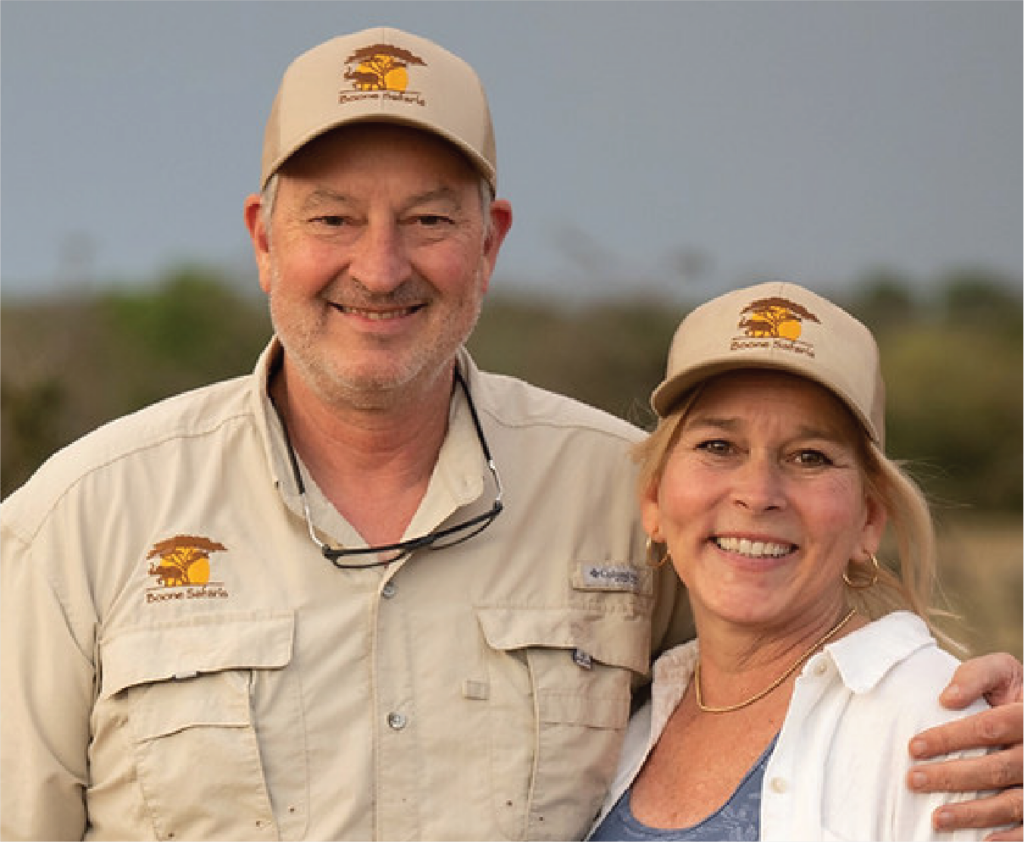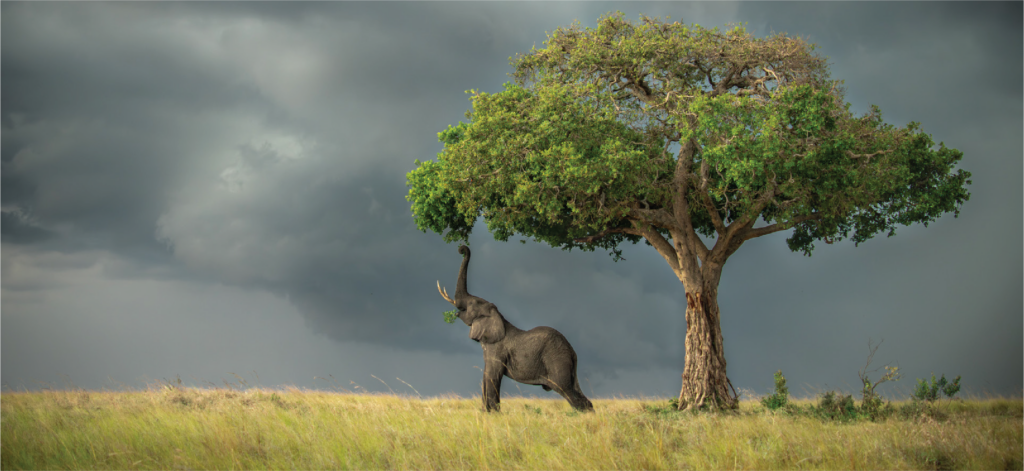A Lens and a Legacy

It’s something Thomson would never have imagined he’d be doing for a living: leading small-group photographic safaris.
On this last trip, a mother leopard called her two cubs to come out of hiding and reunite with her, high up in a jackalberry tree. Jan Shealy, who traveled with her husband, Tommy, was blown away. “I don’t even know where to begin,” she says. “What an adventure!” It was Shealy’s first safari.
Thomson’s own first safari was in 2015. Recently retired from the recruiting business he owned and operated for almost two decades, Thomson is now in his fifth year of taking clients and friends to places like Zimbabwe’s Victoria Falls and Kenya’s Maasai Mara National Reserve through his company, Boone Safaris.
2024 is the first year in which his passion for wildlife will be his full-time occupation.
Going Pro
The dream hatched from a simple hobby. When his kids were growing up, Thomson took pictures of them for fun. “I even became the sports photographer at their high school,” he says. When one of his sons advanced to college football, Thomson happily focused his camera on the field and became the official photographer for Yale University’s football team during his son’s first year of school.
Once his kids graduated, space opened in Thomson’s life, so he started aiming his lens at landscapes and wildlife instead. He especially loved photographing the larger fauna at Grand Teton National Park in Wyoming.
Thomson studied the work of professional photographers and followed them on social media. One day, he happened upon a GoFundMe campaign for a renowned wildlife photographer. In exchange for a donation, the photographer would join him on a safari to watch the Great Migration in the Maasai Mara.
The trip turned out to be the most exhilarating of his life. “I vividly remember the first time I saw a lion in the wild,” Thomson says. “There were no fences. It was just a lion out there lying down, sleeping. I probably cried. Seeing a leopard in real life, a cheetah, massive herds of wildebeest, and zebra as far as the eye could see, it was a spiritual experience.”
Thomson’s pastime evolved into a calling. He traveled and studied with California-based photographer Roy Toft. “I went with him to a workshop in Costa Rica, then to Brazil to photograph jaguars, then to Botswana, and then to Patagonia to photograph pumas,” Thomson says. “I thought he had the coolest job in the world.”
Soon, Thomson’s safari habit became too costly to keep up, and he got the idea to start Boone Safaris. He has been sharing his passion for African wildlife ever since.
By Land, Air, or Water
Thomson’s photographs brim with emotion. Some feel like portraits, capturing an animal’s personality and mood. A muscular hippo tilts its head, looking back over its massive round shoulder as if asking a question. A delicate bird with a pointy beak passes a winged insect to its mate. A cheetah cub, mid-leap, looks as playful as a preschooler.
One of Thomson’s goals is to become certified as an African field guide. To that end, he’s spent hundreds of hours studying African species and their behaviors. A benefit of his deep knowledge is that it gives him an advantage in setting up shots and sharpening his photography.
“When a lion comes into the pride, the first thing it does is make contact with the other lions,” he says. “They rub their heads together.” Because he can anticipate this behavior, Thomson can make sure he’s in position to capture the best shot.
At Boone Safaris, guests choose from different types of game drives and viewing. “The most common one is a specialized Land Cruiser that gets you very close to the animals,” he says.
“If you’re still and quiet, the elephants will come right up to you.” Another option is a hot air balloon, drifting above big herds of animals as they cross the reserves.

“We also do walking game drives in a private conservancy in Kenya,” Thomson says. “We go out with a Maasai warrior who knows the land.”
On his most recent trip, Thomson led a game drive by small boat on the Chobe River. “You’re down low in the water, pulling up next to hippos, and the elephants are swimming across,” he says.
Thomson notes that hippos may react when humans get close. “Hippos can charge. They’re fast in the water, and they’re powerful, but they don’t swim. They run on the bottom. If they charge, our boat driver will speed away, and the boats are custom designed so that they won’t tip over.”
Close Encounters
Getting close to large animals is a thrill. For Gardner Lee, of Birmingham, Alabama, traveling with Boone Safaris in 2022 was also a precious opportunity to bond with his daughter, Anna. In Kenya, a male lion approached their vehicle. “What we didn’t notice was a female lion slipping up along the side,” he says.
“With my daughter’s camera focused on the male, the female jumped from a creek bed toward the truck and came within five feet of Anna,” says Lee. “The entire vehicle let go of one big gasp.”
They also watched a pride of female lions track down a herd of wildebeests and pick out the weakest. “Seeing these animals in the wild as they have existed for millennia makes you feel like you are a part of the past,” Lee says. “It gives you a new appreciation for our ancestors. It awakens you to your basic instincts as a human being.” He left with a lasting desire to help preserve the animals’ ways of life, away from civilization.
To Love and Protect
For Thomson, Boone Safaris means much more than simply turning a profit. He wants to raise awareness of conservation efforts. Visitors to Africa often focus on seeing big game animals, but Thomson loves to introduce them to lesser-known species as well, like his favorite, the painted dog.
These big-eared, mottled canines are among the most endangered animals in Africa. Thomson became fascinated with them after befriending a researcher who had studied them for decades. Painted dogs are sociable; they hunt in groups. They have only four toes on each foot, an adaptation that makes them extremely agile. “Their intelligence and cooperation make them the most successful hunters in the animal kingdom,” Thomson says.

Once considered problem animals, painted dogs were frequently killed on sight by ranchers. There are only 6,600 living today. “Europeans gave them the name wild dog, and that name really stuck, but it sounds like a feral domestic dog that deserves to be shot,” Thomson says. “At Boone Safaris, we give 1 percent of our revenue to the Painted Dog Research Trust [PDRT].”
Thomson had the chance to stay at the PDRT compound for five days during his recent trip. He slept in a small hut and observed the work being done by Zimbabwean university students. The students were viewing recent camera trap images and identifying individual pack members. Thomson says he was taken aback to see the name of one of the dogs. It was Boone.
Startled for a moment, he then remembered that his daughter had the privilege of naming a new dog two years ago when she worked at PDRT. She had named this one after her father.
Some of Thomson’s clients have been so moved by their experiences in Africa that they have allocated a portion of their charitable giving to causes like the painted dog and the Maasai community. “You’re probably not going to do that if you haven’t been here,” Thomson says.
As the Senegalese conservationist Baba Dioum put it, “In the end, we will conserve only what we love; we will love only what we understand; and we will understand only what we are taught.”
For Thomson, love and conservation are entwined. “I don’t want to have a company just to make money and build a big business,” he says. “I want to take people on safari so they’ll appreciate these animals and want to protect them.”
Article by Jeanne Lee. Photographs by Boone Thomson.